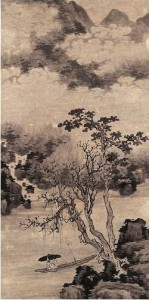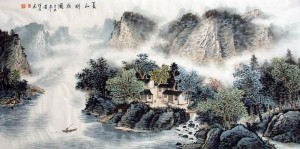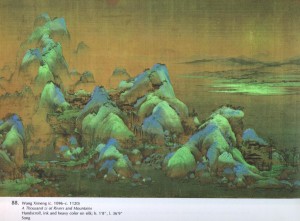陈淳出生于1483年。他住在苏州,跟文征明学习书法。文征明被认为是在苏州的四大绘画大师之一。 然后他离开文征明,所以他可以试试不同的画风。这时间他画“水墨画”。 米黻对陈淳的画有很大的影响。 虽然陈淳主要画花鸟,但是我相信这画是他画的最好的一张。 在这画里,有山有水,呈现出一道亮丽的风景。大部份的山是被云遮住的. 这画包括树木和灌木。在背景里有一艘船在河中,树分成了两部分,一部分是枯的,另外一半是有生机的。这很有趣,因为我们大多只看到一条河。 如果我是这画里面,我会选坐择在两个不同的地方坐着。第一,我会选树的旁边,能够同时观察到山脉和河流。 第二,我会选在船上,因为这是陈淳画一个人,所以我觉得这是因为他要我在这里看景色。我觉得在这些地方让我看这个风景,所以我可以理解自然的美丽。
Chen Chun was born in 1483. He lived in Suzhou and learned calligraphy from Wen Zhenming. Wen Zhengming was considered one of the four masters of painting in Suzhou. We he separated with Wen Zhengming Chen Chun decided to use a new method called “ink wash paintings”. Mi Fu had a major influence on Chen Chun’s paintings. Although, Chen Chun is known for his bird and flower paintings I feel that this is one of his best. In the painting there is a river and several mountains, it is a beautiful landscape. Most of the mountain is obscured by clouds. This painting as includes a single tree as well as bushes. In the background we see an individual in a boat on the water. The tree appears to have two halves one of which is dead and one that is alive. This is interesting because we generally regard rivers as bringing life. If I were inside this painting I would choose to places to be. First, I would choose next to the tree as this would allow me to see the river and mountains in tandem. The second spot I would choose would be in the boat because this is where Chen Chun painted the only individual, so I feel like this is where he would want me to look at the scenery. I feel like these places let me look at the scenery so that I can understand nature’s beauty.






